Low-Complexity Hybrid Optical OFDM with High Spectrum Efficiency for Dimming Compatible VLC System
Abstract
:1. Introduction
- The conceived DCHO-OFDM signal is beneficially composed of the unclipped ACO-OFDM signal and the down/upper-clipped unipolar PAM-DMT signal, where the time-varying bias is further facilitated to diminish the undesired non-linear distortion. In this way, the proposed DCHO-OFDM achieves a higher spectrum efficiency than the conventional schemes over a broad dimming range.
- Thanks to the elaborately combined signal, the symbol transmitted by the proposed DCHO-OFDM is capable of being recovered without detecting the PWM signal, which is superior to the existing digital dimming approaches. Additionally, the BER performance of DCHO-OFDM is invulnerable to the various duty cycles of PWM, achieving a steady system performance in a wide dimming range compared to DCO-OFDM.
- Moreover, the information-carried subcarriers in the proposed DCHO-OFDM scheme can avoid the corruption by the generated interference. As a benefit, the symbols transmitted by the proposed DCHO-OFDM can be readily detected upon relying on a standard OFDM receiver, which significantly reduces the complexity at receiver compared to the existing advanced transmission schemes, such as HACO-OFDM and LACO-OFDM.
2. Brief Review of HACO-OFDM
3. Proposed Dimming Compatible Hybrid O-OFDM
3.1. Pulse Width Modulation
3.2. DCHO-OFDM
3.3. Complexity Analysis
4. Numerical Results
5. Conclusions
Author Contributions
Funding
Conflicts of Interest
Appendix A
Appendix B
References
- Pathak, P.; Feng, X.; Hu, P.; Mohapatra, P. Visible light communication, networking and sensing: A survey, potential and challenges. IEEE Commun. Surv. Tutor. 2015, 17, 2047–2077. [Google Scholar] [CrossRef]
- Bai, X.; Li, Q.; Tang, Y. A low-complexity resource allocation algorithm for indoor visible light communication ultra-dense networks. Appl. Sci. 2019, 9, 1391. [Google Scholar] [CrossRef]
- Grobe, L.; Paraskevopoulos, A.; Hilt, J.; Schulz, D.; Lassak, F.; Hartlieb, F.; Kottke, C.; Jungnickel, V.; Langer, K. High-speed visible light communication systems. IEEE Commun. Mag. 2013, 51, 60–66. [Google Scholar] [CrossRef]
- Rehman, S.; Ullah, S.; Chong, P.; Yongchareon, S.; Komosny, D. Visible light communications: A system perspective-Overview and challenges. Sensors 2019, 19, 1153. [Google Scholar] [CrossRef] [PubMed]
- Feng, S.; Zhang, R.; Li, X.; Wang, Q.; Hanzo, L. Dynamic throughput maximization for the user-centric visible light downlink in the face of practical considerations. IEEE Trans. Wirel. Commun. 2018, 17, 5001–5015. [Google Scholar] [CrossRef]
- Zuo, Y.; Zhang, J. A novel coding based dimming scheme with constant transmission efficiency in VLC systems. Appl. Sci. 2019, 9, 803. [Google Scholar] [CrossRef]
- Feng, S.; Zhang, R.; Xu, W.; Hanzo, L. Multiple access design for ultra-dense VLC networks: Orthogonal vs non-orthogonal. IEEE Trans. Commun. 2019, 67, 2218–2232. [Google Scholar] [CrossRef]
- Chen, Y.; Li, S.; Liu, H. Dynamic frequency reuse based on improved tabu search in multi-user visible light communication networks. IEEE Access 2019, 7, 35173–35183. [Google Scholar] [CrossRef]
- Li, B.; Feng, S.; Xu, W.; Li, Z. Interference-free hybrid optical OFDM with low-complexity receiver for wireless optical communications. IEEE Commun. Lett. 2019, 23, 818–821. [Google Scholar] [CrossRef]
- Chen, L.; Krongold, B.; Evans, J. Performance analysis for optical OFDM transmission in short-range IM/DD systems. J. Lightw. Technol. 2012, 30, 974–983. [Google Scholar] [CrossRef]
- Dissanayake, S.; Armstrong, J. Comparison of ACO-OFDM, DCO-OFDM and ADO-OFDM in IM/DD systems. J. Lightw. Technol. 2013, 31, 1063–1072. [Google Scholar] [CrossRef]
- Ranjha, B.; Kavehrad, M. Hybrid asymmetrically clipped OFDM-based IM/DD optical wireless system. J. Opt. Commun. Netw. 2014, 6, 387–396. [Google Scholar] [CrossRef]
- Wang, Q.; Qian, C.; Guo, X.; Wang, Z.; Cunninghan, D.; White, L. Layered ACO-OFDM for intensity-modulated direct-detection optical wireless transmission. Opt. Express 2015, 23, 12382–12393. [Google Scholar] [CrossRef] [PubMed] [Green Version]
- Wang, T.; Hou, Y.; Ma, M. A novel receiver design for HACO-OFDM by time-domain clipping noise elimination. IEEE Commun. Lett. 2018, 22, 1862–1865. [Google Scholar] [CrossRef]
- Sun, Y.; Yang, F.; Gao, J. Comparison of hybrid optical modulation schemes for visible light communication. IEEE Photon. J. 2017, 9. [Google Scholar] [CrossRef]
- Feng, S.; Bai, T.; Hanzo, L. Joint power allocation for the multi-user NOMA-downlink in a power-line-fed VLC network. IEEE Trans. Veh. Technol. 2019, 68, 5185–5190. [Google Scholar] [CrossRef]
- Gancarz, J.; Elgala, H.; Little, T. Impact of lighting requirements on VLC systems. IEEE Commun. Mag. 2013, 51, 34–41. [Google Scholar] [CrossRef]
- Wang, Z.; Zhong, W.; Yu, C.; Chen, J.; Francois, C.; Chen, W. Performance of dimming control scheme in visible light communication system. Opt. Exp. 2012, 20, 18861–18868. [Google Scholar] [CrossRef]
- Wang, Q.; Wang, Z.; Dai, L. Asymmetrical hybrid optical OFDM for visible light communications with dimming control. IEEE Photon. Technol. Lett. 2015, 27, 974–977. [Google Scholar] [CrossRef]
- Stevens, N.; Strycker, L.D. Single Edge Position Modulation as a Dimming Technique for Visible Light Communications. J. Lightw. Technol. 2016, 34, 5554–5560. [Google Scholar] [CrossRef]
- Hany, E.; Little, T. Reverse polarity optical-OFDM (RPO-OFDM): Dimming compatible OFDM for gigabit VLC links. Opt. Exp. 2013, 21, 24288–24299. [Google Scholar]
- Yang, F.; Gao, J. Dimming control scheme with high power and spectrum efficiency for visible light communications. IEEE Photon. J. 2017, 9. [Google Scholar] [CrossRef]
- Li, B.; Xu, W.; Feng, S.; Li, Z. Spectral-efficient reconstructed LACO-OFDM transmission for dimming compatible visible light communications. IEEE Photon. J. 2019, 11. [Google Scholar] [CrossRef]
- Lee, K.; Park, H. Modulations for visible light communications with dimming control. IEEE Photon. Technol. Lett. 2011, 23, 1136–1138. [Google Scholar] [CrossRef]
- Armstrong, J.; Lowery, A. Power efficient optical OFDM. Electron. Lett. 2006, 42, 1. [Google Scholar] [CrossRef]
- Li, B.; Xu, W.; Zhang, H.; Zhao, C.; Hanzo, L. PAPR reduction for hybrid ACO-OFDM aided IM/DD optical wireless vehicular communications. IEEE Trans. Veh. Technol. 2017, 66, 9561–9566. [Google Scholar] [CrossRef]
- Lee, S.; Randel, S.; Breyer, F.; Koonen, A. PAM-DMT for intensity-modulated and direct-detection optical communication systems. IEEE Photon. Technol. Lett. 2009, 21, 1749–1751. [Google Scholar] [CrossRef]
- Islim, M.; Haas, H. Augmenting the spectral efficiency of enhanced PAM-DMT-based optical wireless communications. Opt. Express 2016, 24, 11932–11949. [Google Scholar] [CrossRef] [PubMed] [Green Version]
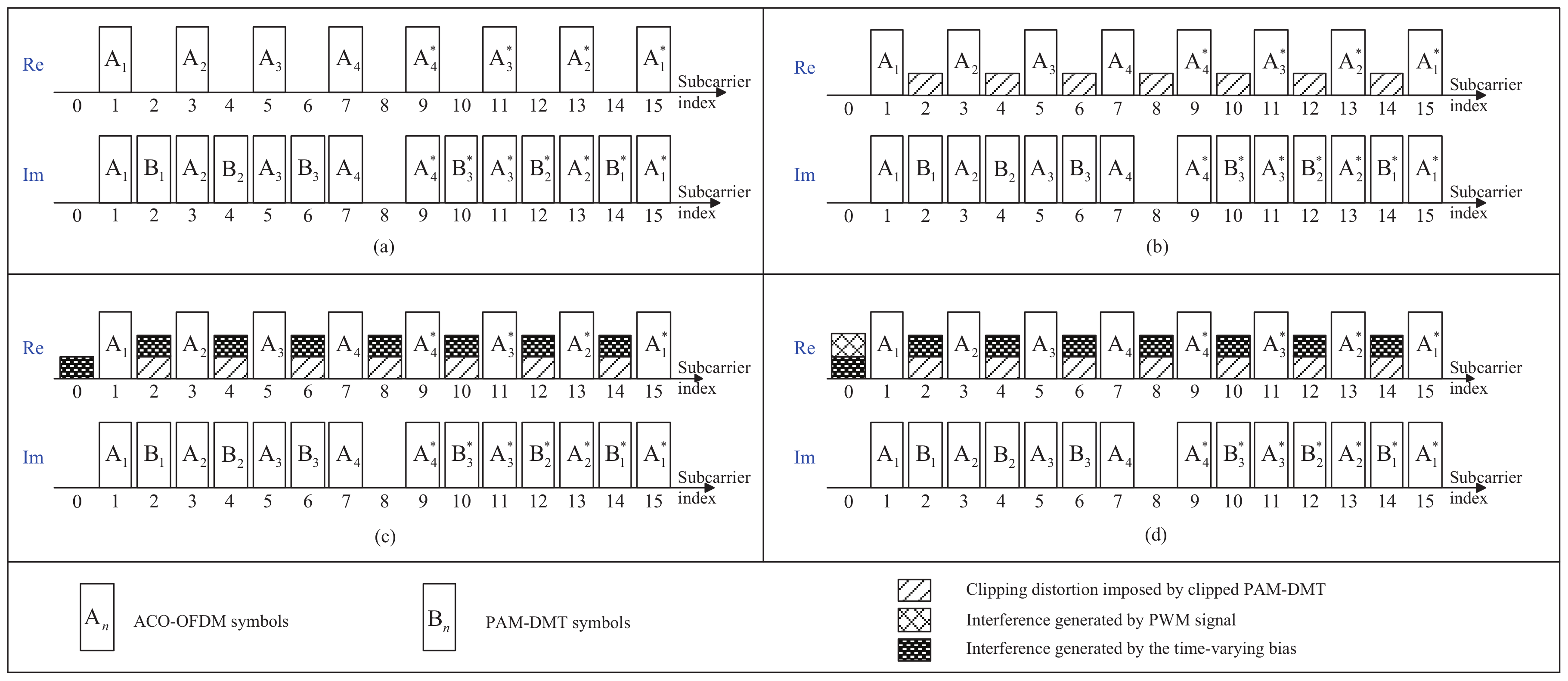
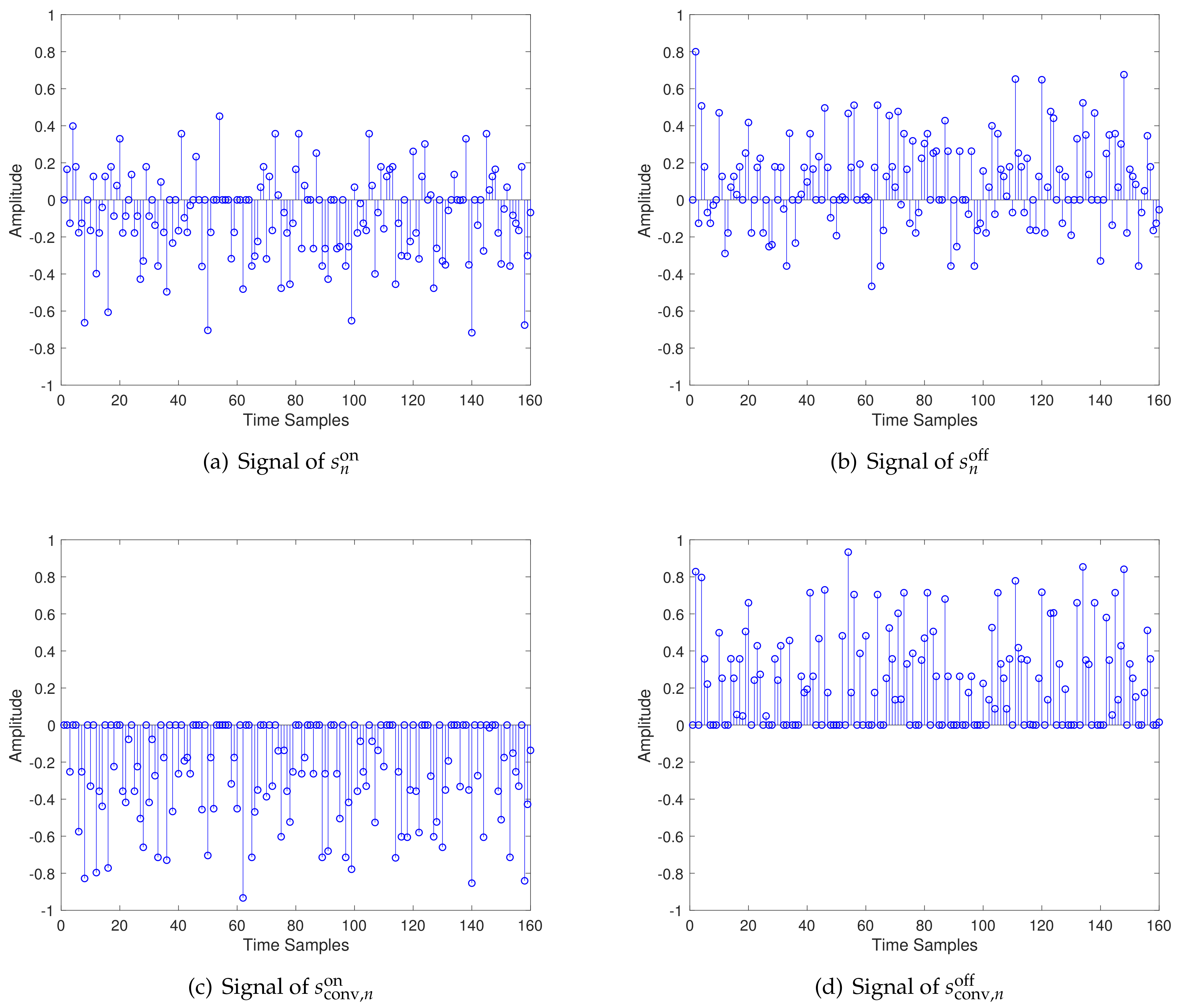
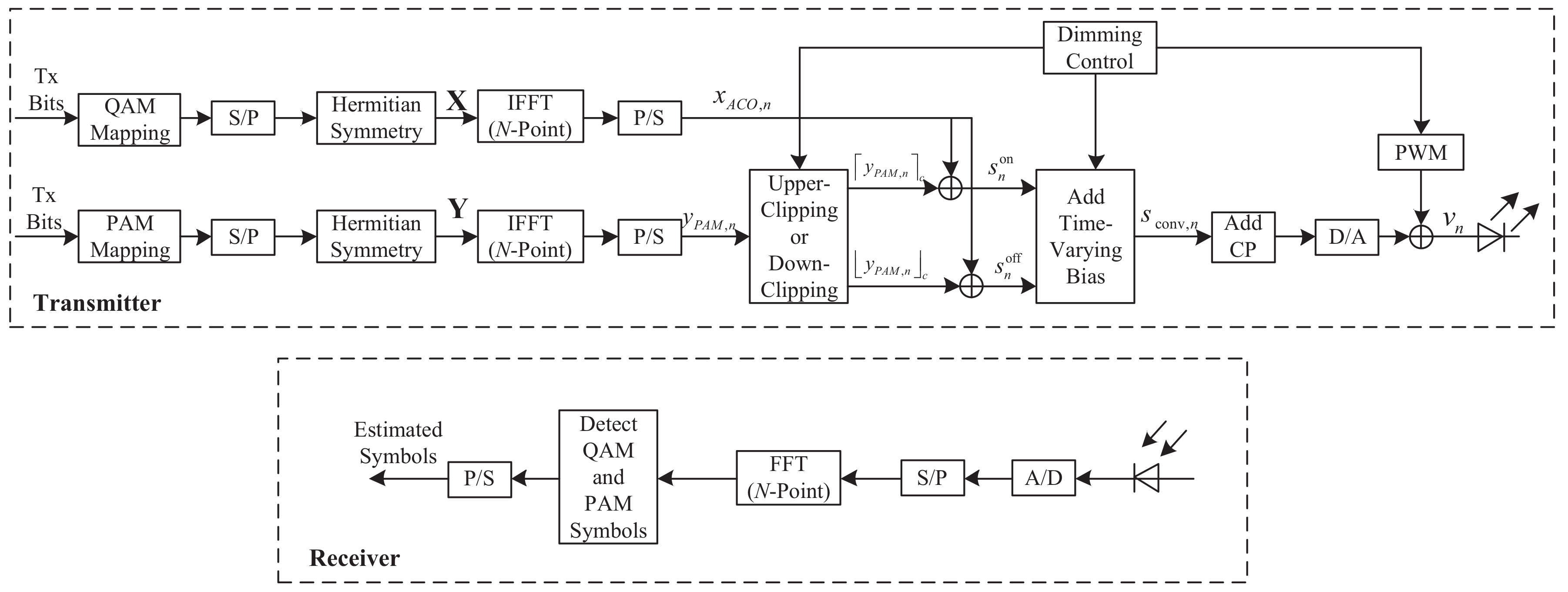

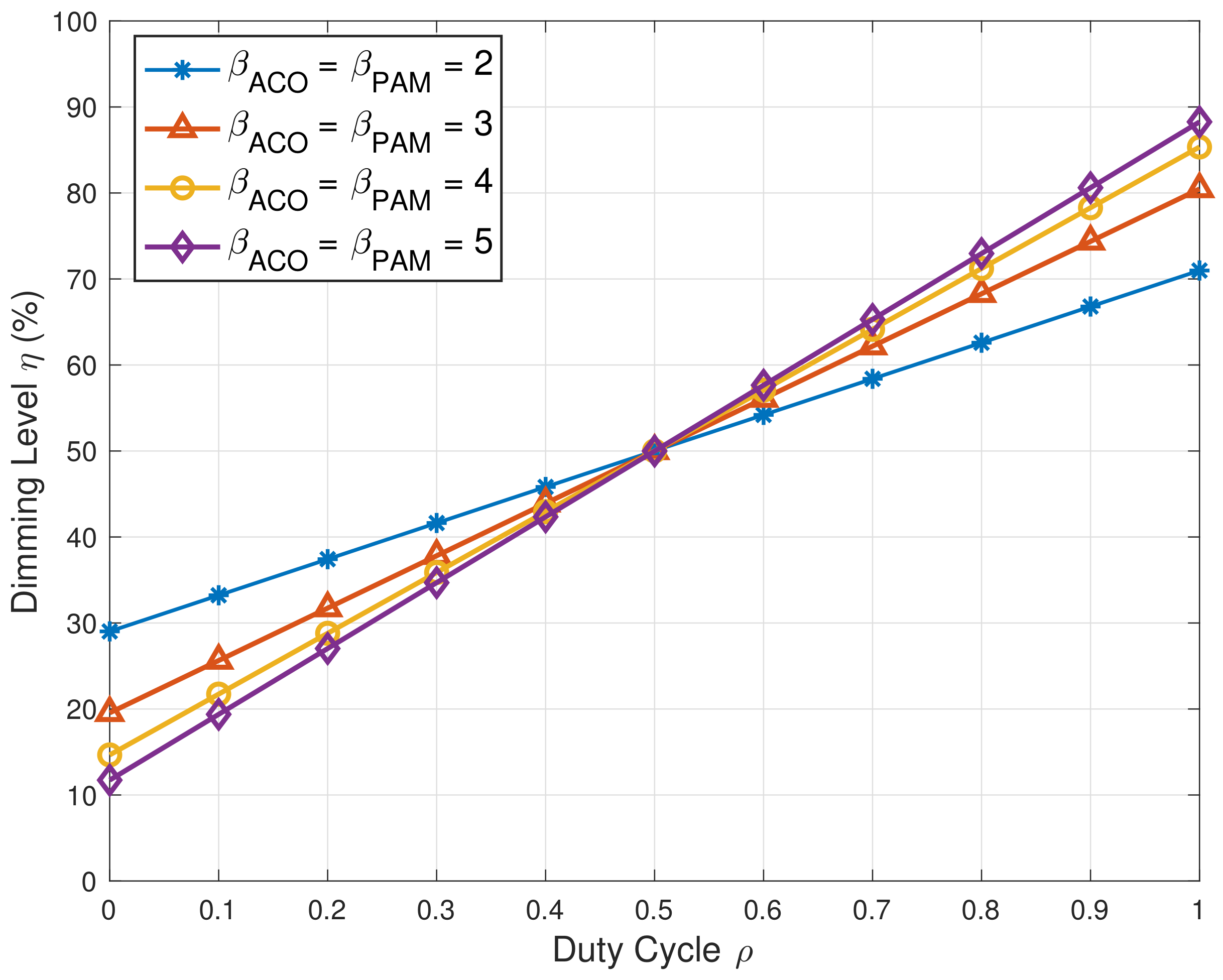

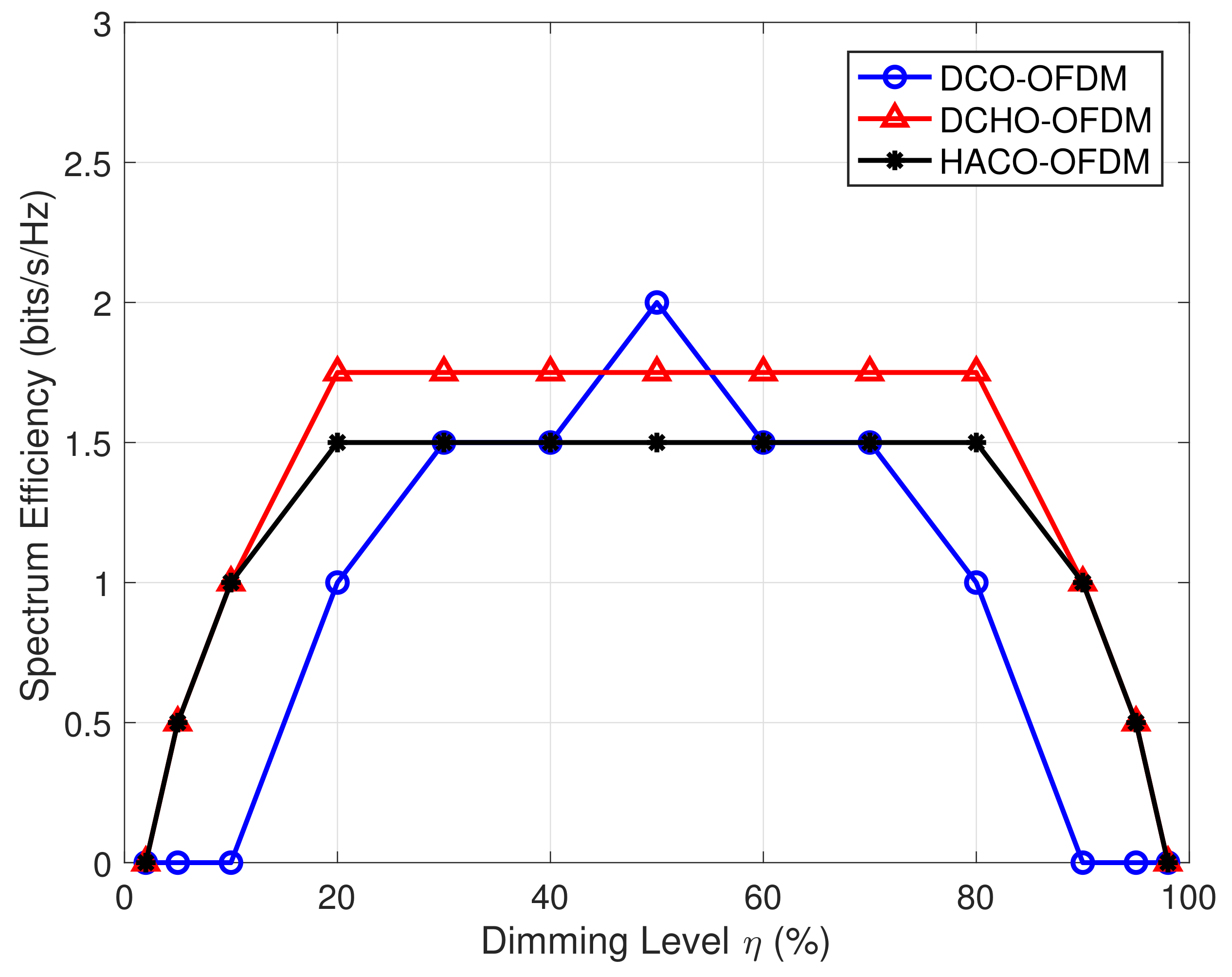
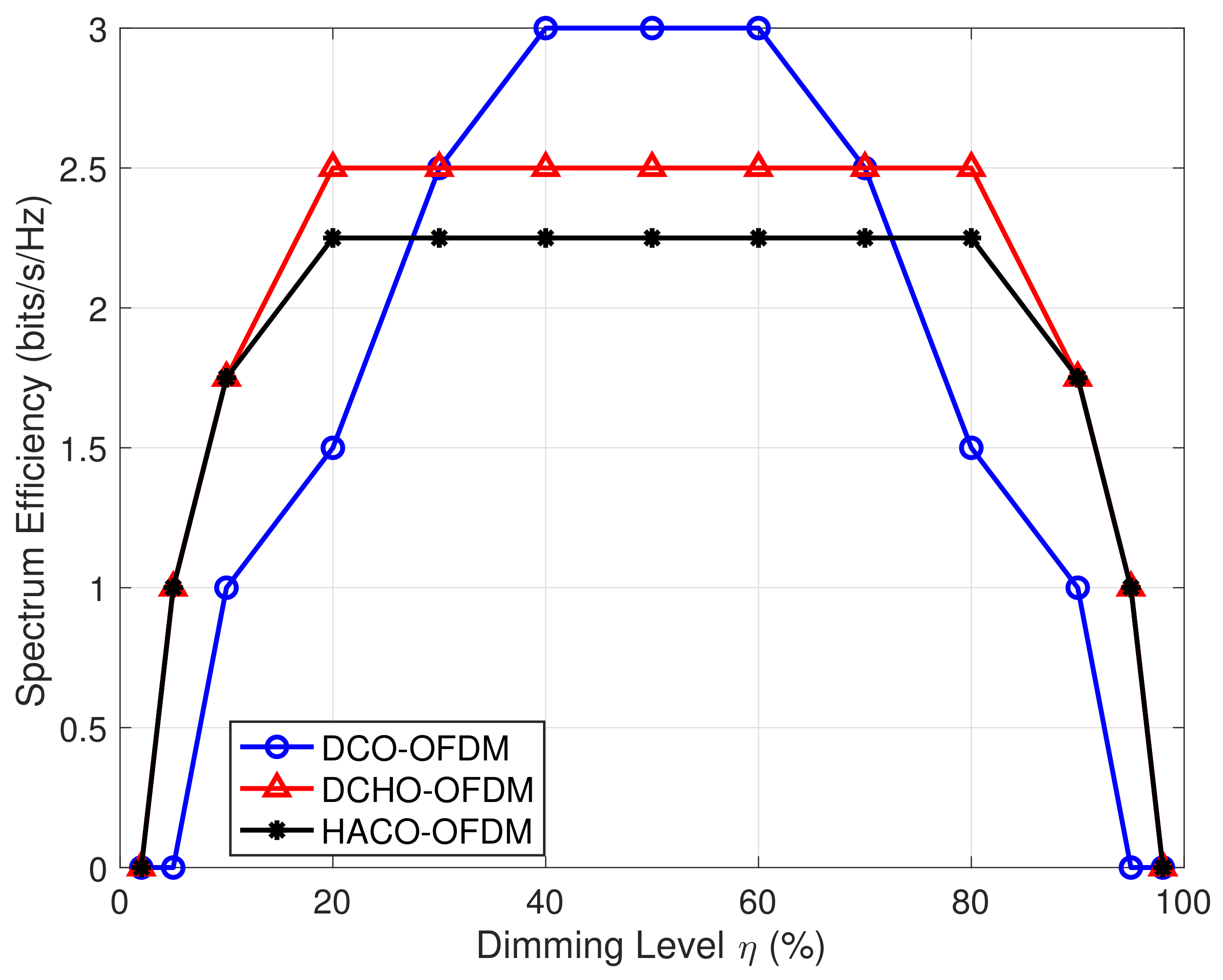
© 2019 by the authors. Licensee MDPI, Basel, Switzerland. This article is an open access article distributed under the terms and conditions of the Creative Commons Attribution (CC BY) license (http://creativecommons.org/licenses/by/4.0/).
Share and Cite
Feng, S.; Feng, H.; Zhou, Y.; Li, B. Low-Complexity Hybrid Optical OFDM with High Spectrum Efficiency for Dimming Compatible VLC System. Appl. Sci. 2019, 9, 3666. https://doi.org/10.3390/app9183666
Feng S, Feng H, Zhou Y, Li B. Low-Complexity Hybrid Optical OFDM with High Spectrum Efficiency for Dimming Compatible VLC System. Applied Sciences. 2019; 9(18):3666. https://doi.org/10.3390/app9183666
Chicago/Turabian StyleFeng, Simeng, Hailiang Feng, Ying Zhou, and Baolong Li. 2019. "Low-Complexity Hybrid Optical OFDM with High Spectrum Efficiency for Dimming Compatible VLC System" Applied Sciences 9, no. 18: 3666. https://doi.org/10.3390/app9183666




